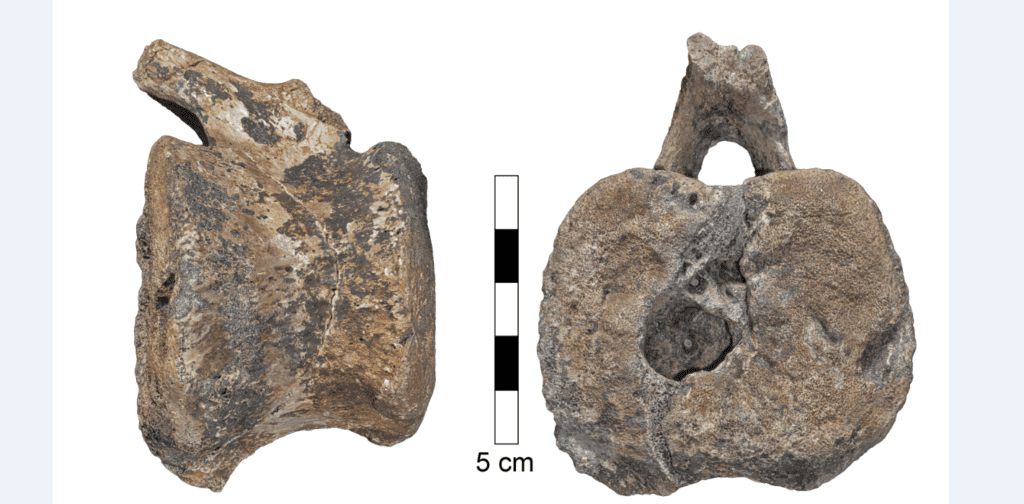It’s odd to think that dinosaurs that roamed the Earth over 60 million years ago suffered from the same type of benign tumor that is today a rare disease in humans – especially children. But this extraordinary finding has been uncovered by scientists at Tel Aviv University (TAU).

The researchers, led by Dr. Hila May of the university’s department of anatomy and anthropology and the Dan David Center for Human Evolution at TAU’s Sackler Faculty of Medicine, identified a tumor called LCH (Langerhans Cell Histiocytosis) in two fossilized tail vertebrae of a young dinosaur that lived in southern Alberta, Canada. This type of growth, a rare disease still found today in humans, can cause significant pain. The findings indicate that the disease is not unique to humans and has survived through the long evolutionary process, from dinosaurs to humans, for over 60 million years.
“Susceptibility to diseases is common to humans and dinosaurs. Since much of the biological history of every living creature is shaped by its diseases, recognizing them in fossilized bone can furnish us with important information on dinosaurs’ physiology and anatomy, as well as on their daily activities and surrounding environment,” the authors wrote.
It is not the first human disease that has been found in dinosaurs. For example, osteoarthritis was “diagnosed” in the bones of the Iguanodon, and diffuse idiopathic skeletal hyperostosis was found in Apatosaurus skeletons.
Cancers, although more difficult to diagnose, have also been identified in dinosaurs. Disease occurrence in dinosaurs is very rare, but when present, it can tell us about dinosaurs’ immune systems, metabolic disorders, growth and adaptation to a huge body mass, infections, environment, as well as shed light on their mating patterns and hunting techniques.
Researchers in North America studying dinosaur fossils identified large cavities, evidently created by tumors, in two tail vertebrae of a young dinosaur discovered in Canada, said May. “The dinosaur belonged to the genus Hadrosaurus, also known as ‘duck-billed dinosaurs’ – herbivores common almost all over the world about 66 million and80 million years ago.” They are also known as “duck-billed dinosaurs.” They reached a length of over 10 meters, weighed several tons and appear to have lived in large herds. They are particularly well-known in southern Alberta, Canada where individual bones and teeth occur in abundance.
The specific shape of the cavities caught the researchers’ attention –they were very similar to cavities created by the rare tumor LCH, which still affects people today. This benign tumor, found mostly in the bones of children aged two to 10 years, can cause pain, but often disappears by itself.
The dinosaur’s vertebrae were sent to the Shmunis Family Anthropology Institute at the Dan David Center in the Faculty of Medicine, which is located at the Steinhardt Museum of Natural History, for inspection with the institute’s advanced micro-CT scanner.

Other contributors to the study include Prof. Bruce Rothschild of Indiana University in the US; Prof. Frank Rühli of the University of Zurich in Switzerland; and Darren Tanke of the Royal Tyrrell Museum of Paleontology in Alberta. The paper has just been published in the journal Scientific Reports.
Hadrosaurs were unique among dinosaurs regarding their susceptibility to neoplastic processes, both benign and malignant. Nevertheless, this study is the first to suggest a case of LCH in the fossil record and the first to provide evidence-based criteria (predicated on findings in individuals diagnosed in life) for its recognition in skeletons, when soft tissue structures cannot be assessed, the authors continued.
“The micro-CT scanner generates images with a very high resolution of up to a few microns,” noted May. “Using it to scan the dinosaur vertebrae, we were able to form a reconstructed 3D image of the tumor and the blood vessels leading to it. The image confirmed in a high probability that the dinosaur did indeed suffer from LCH. The surprising findings indicate that the disease is not unique to humans and that it existed in different species over 60 million years – through the long evolutionary process from dinosaurs to humans.”
“Research of this kind, made possible by current technology, contributes a great deal to evolutionary medicine – a relatively new field of research which investigates the development and behavior of diseases over time,” added Prof. Israel Hershkovitz from the Dan David Center who has studied malignant tumors in dinosaurs and who helped in the identification of the LCH tumor. “Evolutionary medicine researchers try to understand why certain diseases have survived through millions of years of evolution and to discover their source, in order to ultimately develop new and effective ways to address them today.”
***



